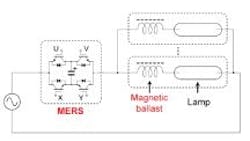More efficient lighting thanks to magnetic energy recovery switch
The Office of Naval Research branch in Tokyo has worked with researchers from the Tokyo Institute of Technology to install what's called a Magnetic Energy Recovery Switch (MERS) that saves on light bills.
A presentation on the basics of the MERS device, http://www.ryutu.inpit.go.jp/seminar_a/2010/pdf/25/A2/A2-02.pdf
The MERS is basically a four-transistor active snubber circuit that effectively synthesizes a tunable capacitor. When hooked up with an external inductor, one of the uses of the device is to adjust circuit power factor. When used with fluorescent lamps, the MERS can function as a dimmer.
The Navy wants to run the same experiment in the entire Hardy Barracks Installation so that it extends into areas that include a break room, printing press room, laundry room, gymnasium and several offices.
More info:
MERSTech, http://www.merstech.com/en/technology.html
ONL announcement of the MERS experiement, http://www.onr.navy.mil/Media-Center/Press-Releases/2010/Magnetic-Energy-Recovery-MERS.aspx
